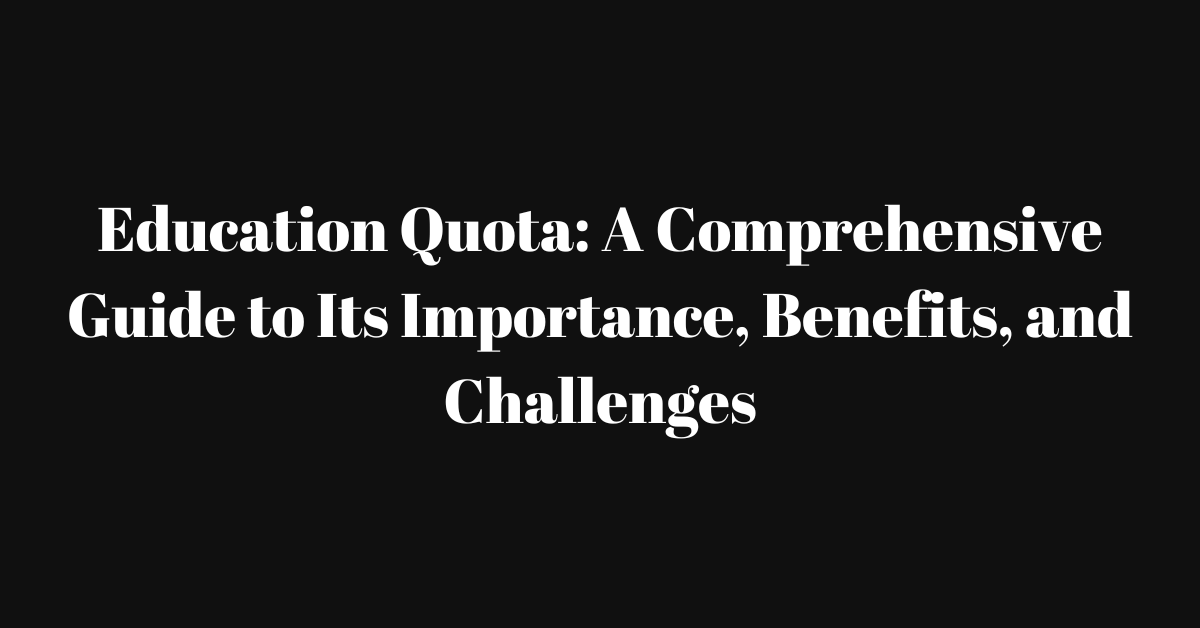Introduction
Education is a fundamental right that plays a crucial role in shaping an individual’s future. However, not everyone has equal access to educational opportunities due to economic, social, or geographical barriers. To bridge this gap, the concept of education quota has been introduced in many countries. This system reserves a certain percentage of seats in educational institutions for underprivileged and marginalized communities, ensuring inclusivity and diversity in academia.
This article explores the education quota system, its importance, benefits, challenges, and its impact on society.
What Is Education Quota?
Education quota is a reservation policy where a percentage of seats in schools, colleges, and universities are allocated to specific groups based on various criteria, such as socio-economic background, caste, ethnicity, gender, disability, or regional backwardness. It aims to provide equal educational opportunities to those who face systemic disadvantages.
Types of Education Quotas
- Caste-Based Quota: Reserved for historically disadvantaged communities (e.g., Scheduled Castes, Scheduled Tribes, and Other Backward Classes in India).
- Economic Quota: Benefits students from economically weaker sections (EWS) of society.
- Gender-Based Quota: Encourages female participation in education, especially in STEM fields.
- Disability Quota: Provides reservations for students with disabilities to ensure equal access.
- Sports Quota: Helps talented athletes gain admission to institutions based on their sporting achievements.
- Military/Defense Quota: Supports the children of armed forces personnel.
- State/Regional Quota: Offers seats to students from specific states or regions, promoting local representation.
Importance of Education Quota
The education quota system plays a vital role in reducing disparities and fostering social and economic equality. Below are some of its key benefits:
- Promotes Social Inclusion
- Helps marginalized communities integrate into mainstream education and society.
- Reduces discrimination based on caste, gender, and economic background.
- Bridges Economic Gaps
- Provides financial relief to students from low-income families by granting them access to prestigious institutions.
- Encourages Higher Education
- Motivates students from disadvantaged backgrounds to pursue higher education, which they might have otherwise abandoned.
- Enhances Diversity in Educational Institutions
- Creates a multicultural and inclusive environment, fostering mutual understanding and respect.
- Boosts National Development
- A well-educated population leads to economic growth, innovation, and societal progress.
Challenges and Criticism of the Education Quota System
While the education quota system has several advantages, it also faces criticism and challenges, including:
- Merit vs. Reservation Debate
- Critics argue that reservation policies may compromise meritocracy by admitting less-qualified students over more deserving candidates.
- Misuse and Corruption
- Cases of fake caste or income certificates have been reported, leading to undeserving candidates availing quota benefits.
- Limited Seats, High Competition
- The number of reserved seats is often limited, making the competition tough even among the quota-eligible candidates.
- Social Stigma
- Some students admitted through quotas face discrimination and prejudice from peers and faculty.
- Lack of Proper Implementation
- Inefficiencies in execution, lack of awareness, and bureaucratic hurdles often prevent deserving candidates from benefiting.
Global Perspective on Education Quotas
Several countries have implemented education quotas to promote inclusivity:
- India: The reservation system is based on caste, economic status, and disability, with quotas in government-run and private institutions.
- Brazil: Implements racial quotas for Afro-Brazilians and indigenous students.
- United States: Affirmative action policies focus on racial and socio-economic diversity.
- South Africa: Ensures education access for historically oppressed communities.
The Future of Education Quotas
The education quota system must evolve to address emerging challenges and ensure fair and effective implementation. Some possible reforms include:
- Income-Based Reservation: Shifting focus from caste-based to economic criteria to benefit truly underprivileged students.
- Merit-Linked Quotas: Combining merit-based and quota-based admissions to maintain educational standards.
- Improved Verification Processes: Stricter measures to prevent misuse and ensure only deserving candidates benefit.
- Awareness Campaigns: Educating eligible students and families about their rights and the application process.
- Skill Development Programs: Providing additional support such as scholarships, mentorship, and training to help quota students excel.
Conclusion
Education quotas have been instrumental in promoting social justice, diversity, and equal opportunity in academic institutions worldwide. While challenges exist, improving the implementation and ensuring a balanced approach between merit and reservation can lead to a more inclusive and equitable education system. By continuously refining policies and addressing inefficiencies, the education quota system can become a powerful tool for socio-economic upliftment.
As the world progresses, a well-planned and inclusive education policy will be key to empowering the next generation and driving sustainable development.
